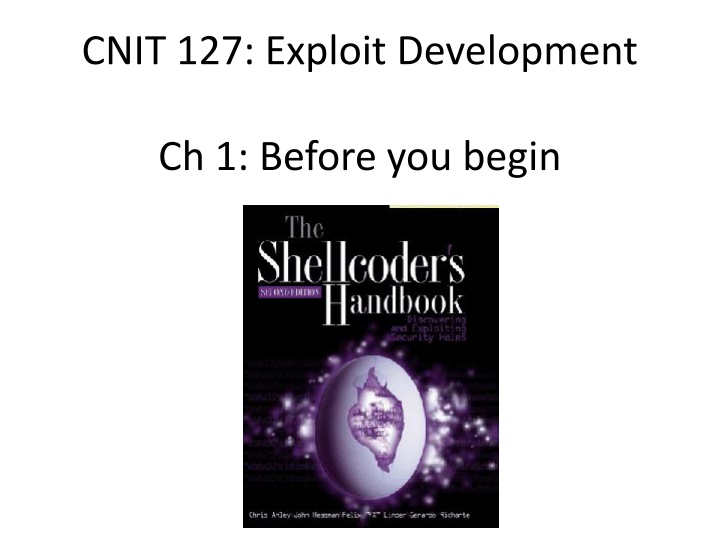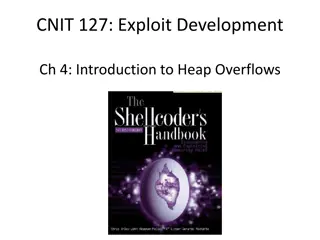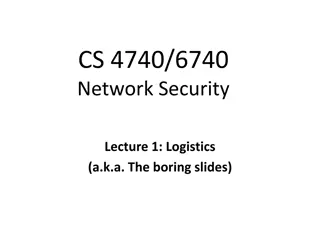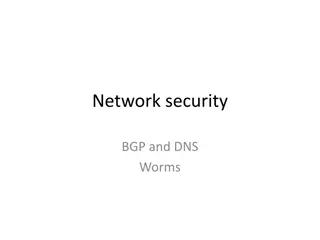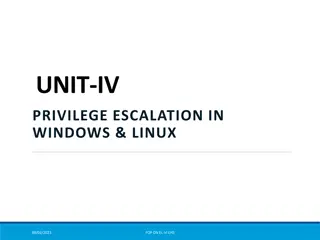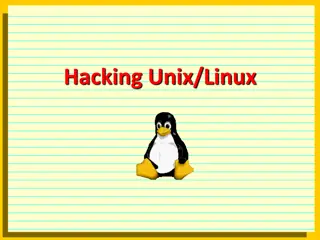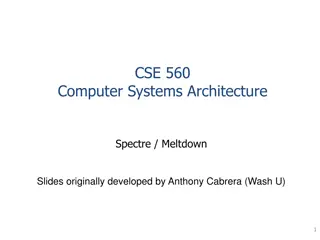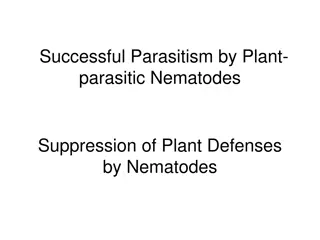Exploit Development Fundamentals
Explore key concepts in exploit development, including vulnerabilities, exploits, 0days, memory management, instructions vs. data, and program address space. Learn about stack manipulation and how to take advantage of system flaws effectively.
Download Presentation

Please find below an Image/Link to download the presentation.
The content on the website is provided AS IS for your information and personal use only. It may not be sold, licensed, or shared on other websites without obtaining consent from the author.If you encounter any issues during the download, it is possible that the publisher has removed the file from their server.
You are allowed to download the files provided on this website for personal or commercial use, subject to the condition that they are used lawfully. All files are the property of their respective owners.
The content on the website is provided AS IS for your information and personal use only. It may not be sold, licensed, or shared on other websites without obtaining consent from the author.
E N D
Presentation Transcript
CNIT 127: Exploit Development Ch 1: Before you begin
Vulnerability A flaw in a system that allows an attacker to do something the designer did not intend, such as Denial of service (loss of availabiltiy) Elevating privileges (e.g. user to Administrator) Remote Code Execution (typically a remote shell)
Exploit Exploit (v.) To take advantage of a vulnerability and cause a result the designer did not intend Exploit (n.) The code that is used to take advantage of a vulnerability Also called a Proof of Concept (PoC)
0Day and Fuzzer 0Day An exploit that has not been publicly disclosed Sometimes used to refer to the vulnerability itself Fuzzer A tool that sends a large range of unexpected input values to a system The purpose is to find bugs which could later be exploited
Memory Management Specifically for Intel 32-bit architecture Most exploits we'll use involve overwriting or overflowing one portion of memory into another Understanding memory management is therefore crucial
Instructions and Data There is no intrinsic difference between data and executable instructions Although there are some defenses like Data Execution Prevention They are both just a series of bytes This ambiguity makes system exploitation possible
Program Address Space Include Actual program instructions Required data Three types of segments .text contains program instructions (read-only) .data contains static initialized global variables (writable) .bss contains uninitialized global variables (writable)
Stack Last In First Out (LIFO) Most recently pushed data is the first popped Ideal for storing transitory information Local variables Information relating to function calls Other information used to clean up the stack after a function is called Grows down As more data is added, it uses lower address values
Heap Holds dynamic variables Roughly First In First Out (FIFO) Grows up in address space
Program Layout in RAM From link Ch 1a (.bss = Block Started by Symbols)
Assembly Language Different versions for each type of processor x86 32-bit Intel (most common) x64 64-bit Intel SPARC, PowerPC, MIPS, ARM others Windows runs on x86 or x64 x64 machines can run x86 programs Most malware is designed for x86
Instructions Mnemonic followed by operands mov ecx 0x42 Move into Extended C register the value 42 (hex) mov ecx is 0xB9 in hexadecimal The value 42 is 0x4200000000 In binary this instruction is 0xB942000000
Endianness Big-Endian Most significant byte first 0x42 as a 64-bit value would be 0x00000042 Little-Endian Least significant byte first 0x42 as a 64-bit value would be 0x42000000 Network data uses big-endian x86 programs use little-endian
IP Addresses 127.0.0.1, or in hex, 7F 00 00 01 Sent over the network as 0x7F000001 Stored in RAM as 0x0100007F
Operands Immediate Fixed values like x42 Register eax, ebx, ecx, and so on Memory address Denoted with brackets, like [eax]
Registers General registers Used by the CPU during execution Segment registers Used to track sections of memory Status flags Used to make decisions Instruction pointer Address of next instruction to execute
Size of Registers General registers are all 32 bits in size Can be referenced as either 32bits (edx) or 16 bits (dx) Four registers (eax, ebx, ecx, edx) can also be referenced as 8-bit values AL is lowest 8 bits AH is higher 8 bits
General Registers Typically store data or memory addresses Normally interchangeable Some instructions reference specific registers Multiplication and division use EAX and EDX Conventions Compilers use registers in consistent ways EAX contains the return value for function calls
Flags EFLAGS is a status register 32 bits in size Each bit is a flag SET (1) or Cleared (0)
Important Flags ZF Zero flag Set when the result of an operation is zero CF Carry flag Set when result is too large or small for destination SF Sign Flag Set when result is negative, or when most significant bit is set after arithmetic TF Trap Flag Used for debugging if set, processor executes only one instruction at a time
EIP (Extended Instruction Pointer) Contains the memory address of the next instruction to be executed If EIP contains wrong data, the CPU will fetch non-legitimate instructions and crash Buffer overflows target EIP
Simple Instructions mov destination, source Moves data from one location to another Intel format is favored by Windows developers, with destination first Remember indirect addressing [ebx] means the memory location pointed to by EBX
lea (Load Effective Address) lea destination, source lea eax, [ebx+8] Puts ebx + 8 into eax Compare mov eax, [ebx+8] Moves the data at location ebx+8 into eax
Arithmetic sub Subtracts add Adds inc Increments dec Decrements mul Multiplies div Divides
NOP Does nothing 0x90 Commonly used as a NOP Sled Allows attackers to run code even if they are imprecise about jumping to it
The Stack Memory for functions, local variables, and flow control Last in, First out ESP (Extended Stack Pointer) top of stack EBP (Extended Base Pointer) bottom of stack PUSH puts data on the stack POP takes data off the stack
Other Stack Instructions All used with functions Call Leave Enter Ret
Function Calls Small programs that do one thing and return, like printf() Prologue Instructions at the start of a function that prepare stack and registers for the function to use Epilogue Instructions at the end of a end of a function that restore the stack and registers to their state before the function was called
Conditionals test Compares two values the way AND does, but does not alter them test eax, eax Sets Zero Flag if eax is zero cmp eax, ebx Sets Zero Flag if the arguments are equal
Branching jz loc Jump to loc if the Zero Flag is set jnz loc Jump to loc if the Zero Flag is cleared
C Main Method Every C program has a main() function int main(int argc, char** argv) argc contains the number of arguments on the command line argv is a pointer to an array of names containing the arguments
Example cp foo bar argc = 3 argv[0] = cp argv[1] = foo argv[2] = bar
Recognizing C Constructs in Assembly
Incrementing C Assembler number dw 0 ... mov eax, number inc eax mov number, eax int number; ... number++; dw: Define Word
Incrementing C Assembler number dw 0 mov eax, number or eax, eax jge label ... label : int number; if (number<0) { ... } or compares numbers, like test (link Ch 1b)
Array C Assembler array dw 0,0,0,0 ... mov ebx, 2 mov array[ebx], 9 int array[4]; ... array[2]=9;
Triangle C int triangle (int width, int height) { int array[5] = {0,1,2,3,4}; int area area = width * height/2; return (area); }
